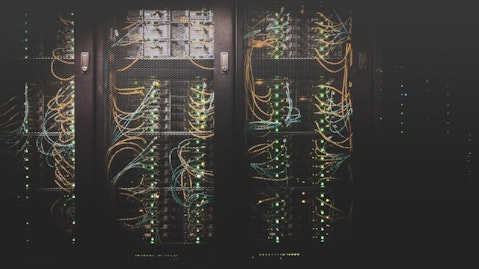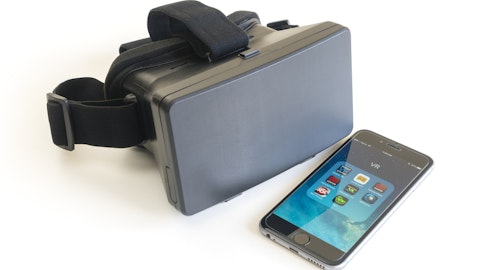In this article, we will be taking a look at the 25 countries with the lowest internet penetration rates in 2023. To skip our detailed analysis, you can go directly to see the 5 countries with the lowest internet penetration rates in 2023.
According to the World Bank, just 26% of the global population had access to the internet in 2009, which has steadily increased significantly to cross 60% in 2021. However, despite the fact that well over half of the global population, or nearly 5 billion people can access the internet, none of the countries with the lowest internet penetration rates in 2023 have even a quarter of their total population able to access the internet, signifying how uneven internet access has been globally, while the countries with the highest internet penetration rates in 2023 all have internet penetration rates above 90%.
The importance of internet to a country’s economy cannot be understated especially in today’s world, where nearly everything is dependent on the internet, especially in developed nations. But it is the lack of internet that is creating further hurdles for some of the poorest countries in the world as internet usage opens up avenues that do not exist otherwise. For example, not only can businesses advertise their products for a fraction of cost to a much wider audience than if they use traditional methods, this lowered cost can be transferred to the consumer which creates a lower burden on disposable income. Additionally, not only can people use the internet to gain any of the millions of jobs available, they can also develop their own businesses or work as freelancers. This is especially relevant in a country where the currency is weak, since they can work for companies in different countries many of which use some of the most powerful currencies in the world, thus also directly increasing disposable income and simulating an economy.

Photo by Taylor Vick on Unsplash
Unfortunately, many of the countries with the lowest internet penetration rates face a whole host of problems when trying to increase internet access. Infrastructure required to be deployed to improve internet access can be costly, and many developing countries have large swathes of population living in rural areas where even existing infrastructure can be negligible. All of this results in additional costs to consumers which can often price them out of being able to access the internet even if it is available. For example, a 20 Mbps internet connection in Pakistan costs $19 a month, with frequent interruptions, and yet, a 600 Mpbs internet connection in Poland, whose purchasing power is significantly higher than Pakistan, costs just $4 more at $23. This is why people whose disposable income is quite low (and in a country battling an economic crisis there are plenty of such people) simply cannot afford proper internet access. Hence, it should come as no surprise to note that Pakistan is among the countries with the lowest internet access rates in the entire world.
A study conducted on The Influence of Internet Penetration on Poverty and Income Inequality had a similar finding stating in its conclusion “Results indicate that the impact of technology use is not consistent across countries and combining countries to form one group to derive results may lead to inappropriate policies. In low-income countries in particular, an increase in Internet users is likely to be beneficial for lowering poverty levels while access to broadband Internet can have a positive effect on reducing income inequality. Therefore, low-income countries are likely to benefit from policies that promote access to Internet services for the masses. The effects of improving access to mobile services and Internet facilities are not linked to easy communication only but also have implications for telehealth services, online education, and remote jobs. An important factor that can strengthen such initiatives is the popularity of smartphones, instead of the traditional mobile phones, even in low-income countries. This means that through provision of Internet services, the common man can be equipped to sustain himself through revenue generating activities online.”
Even the advent of 5G, which provides internet speeds up to 100 times higher than 4G, has so far not really reduced this disparity, with 5G currently overwhelmingly being available in richer countries. If it were to become available in developing countries, that could help change the landscape with respect to high-speed internet access. A document published by GSMA discussed the impact of 5G in Africa, the region with the highest number of countries with the lowest internet penetration in the world, stating “5G is a necessary upgrade to the mobile product, ensuring that it continues to remain relevant to consumers, enterprises, governments and society as a whole. The importance of mobile, and 5G in particular, will become even more profound as the world emerges into a post-Covid-19 scenario where digital technologies and services are increasingly integrated into every aspect of society.” However, the biggest challenge faced in this respect is the lack of fixed broadband penetration, enabling digital transformation and the necessity of boosting tech innovation.
This also shows the massive potential for some of the biggest telecom companies in the world including AT&T Inc. (NYSE:T), Verizon Communications Inc. (NSE:VZ) and T-Mobile US, Inc. (NASDAQ:TMUS), considering the fact that 5G is expected to pass more than 2 billion customers and is being adopted at a faster pace than even 3G or 4G. Further, 5G is expected to continue to evolve massively to the end of this decade, and hence will remain a major investment opportunity well into 2020s.
Methodology
While determining the countries with the lowest internet penetration in 2023, we consulted the countries with populations with the highest percentage of internet access, and checked average internet access percentage across 2017 to 2021, obtaining this data from World Bank. We’ve excluded small islands with populations of less than 100k in our rankings.
25. Togo
Average percentage of population with internet access from 2017 – 2021: 22.5%
Togo’s internet access rate jumped from 12.3% in 2017 to 35% in 2021, which shows that the government has spent considerable resources in improving internet access in the country.
24. Rwanda
Average percentage of population with internet access from 2017 – 2021: 22.4%
Rwanda was one of the first African countries to get Starlink’s service, and its government has an ambition to ensure that al least 60% of its primary schools have internet access by 2024.
23. Tajikistan
Average percentage of population with internet access from 2017 – 2021: 22.0%
Tajikistan is said to be one of the countries with the worst internet in the world, though the country’s President has criticized the head of state communications service in a bid to put pressure and improve internet service in the nation.
22. Tanzania
Average percentage of population with internet access from 2017 – 2021: 21.3%
Tanzania and Uganda recently agreed an internet sharing deal, which should benefit internet access in both nations, with the deal resulting in Tanzania selling National ICT Backbone to Uganda.
21. Turkmenistan
Average percentage of population with internet access from 2017 – 2021: 21.3%
Turkmenistan imposes severe restrictions on internet access and internet in the country is considered to be among the slowest in the world.
20. Comoros
Average percentage of population with internet access from 2017 – 2021: 18.3%
Comoros will be a beneficiary of Meta Platforms, Inc. (NADSAQ:META) working with African and global telecom companies in the biggest subsea cable project in the entire world, which is likely to significantly improve internet penetration in the country.
19. Niger
Average percentage of population with internet access from 2017 – 2021: 17.7%
Niger’s President was recently deposed after a successful coup by the country’s military and is likely to face sanctions from the EU and the U.S., which will hamper improving internet access in the country.
18. Pakistan
Average percentage of population with internet access from 2017 – 2021: 17.2%
A large percentage of Pakistan’s population lives in rural areas where often even electricity supply is infrequent, and internet infrastructure does not exist. However, with mobile data being used more and more in the country, the country could soon drop out of our list of countries with the lowest internet penetration rates in 2023.
17. Afghanistan
Average percentage of population with internet access from 2017 – 2021: 16.6%
In addition to the Taliban’s rule in Afghanistan which has ensured a lack of digital freedom for Afghani women, the rough terrain and landscape in the country also make it really difficult to provide internet access across the country.
16. Zambia
Average percentage of population with internet access from 2017 – 2021: 16.5%
MTN Zambia became the first internet provider in Zambia to launch a 5G network, which could very well result in much higher internet-speed available to a much greater percentage of the total population.
15. Democratic Republic of Congo
Average percentage of population with internet access from 2017 – 2021: 16.5%
Vodacom DRC is one of the biggest internet service providers in the country, and DRC has seen an increase of 167% in terms of internet penetration percentage from 2017 to 2021.
14. Ethiopia
Average percentage of population with internet access from 2017 – 2021: 16.2%
Ethiopia has one of the largest populations of any African country and yet, is still among the countries with the lowest internet penetration rates in 2023. Social media bans aren’t really helping internet penetration in the country and both civilians and businesses are feeling the impact of the recent ban.
13. Sierra Leone
Average percentage of population with internet access from 2017 – 2021: 16.0%
Sierra Leone joined Starlink’s service in June 2023, though censorship did see internet disruption in the country as antigovernment protests raged in August 2022. While internet access is improving in the country, improvements are coming at a slow rate.
12. Malawi
Average percentage of population with internet access from 2017 – 2021: 14.4%
The Malawi Communications Regulatory Authority has stated that internet connectivity is key for improving agricultural productivity in the country, something which is very important to the country’s economy.
11. Mozambique
Average percentage of population with internet access from 2017 – 2021: 13.4%
In June 2023, Starlink went live in Mozambique and this launch is expected to provide internet access to even remote rural areas in the country.
10. Burkina Faso
Average percentage of population with internet access from 2017 – 2021: 12.2%
Burkina Faso is one of the countries Starlink is expected to launch in, which could very well change the internet landscape for the entire country.
9. Madagascar
Average percentage of population with internet access from 2017 – 2021: 12.1%
The Digital and Energy Connectivity for Inclusion in Madagascar Project received a $400 million credit facility from the World Bank in April 2023, with one of the goals of the Project being to improve internet infrastructure in the country and provide internet access to at least 3.4 million people in addition to electricity to more than 10 million, which will also directly contribute in improving internet access.
8. Eritrea
Average percentage of population with internet access from 2017 – 2021: 11.5%
In 2019, Eritrea blocked internet access to social media in a bid to block planned protests, indicating just how prevalent internet censorship is in Africa.
7. Chad
Average percentage of population with internet access from 2017 – 2021: 10.7%
Chad’s improvement in internet penetration is nothing short of remarkable, going from 7.4% in 2017 to nearly 18% in 2021 and if progress continues in a similar vein, it will soon be off our list of countries with the lowest internet penetration rates in the world, despite the country’s President enacting severe internet censorship for more than a year.
6. Congo
Average percentage of population with internet access from 2017 – 2021: 8.7%
The Republic of Congo is one of the most urbanized countries in Africa, but despite this, internet access is still quite low.
Click to continue reading and see 5 countries with the lowest internet penetration rates in 2023.
Suggested Articles:
- Top 20 Spotify Users by Country
- Goldman Sachs Dividend Stocks: Top 12 Stock Picks
- 12 Best NASDAQ ETFs
Disclosure: None. 25 countries with the lowest internet penetration rates in 2023 is originally published on Insider Monkey.





